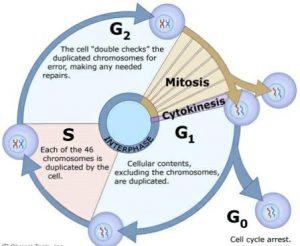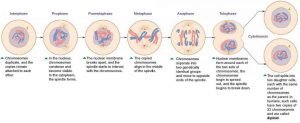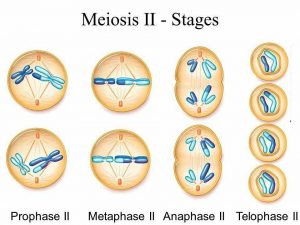Study Notes on Cell Cycle and Cell Divison
CELL CYCLE:
- Basically cell division is a very important process in all living organism.
- Replication of cell, cell growth this kind of processes also takes place by cell division.
- The process in which a sequence of events which is like cell duplicate it’s genome, synthesis the other constituents of the cell and eventually divides into two daughter cell is known as cell cycle.
- DNA synthesise only occurs during one specific stays in the whole cell cycle.
- Replicated chromosome or DNA then distributed into two daughter nuclei by a complex series of events during the cell division process.
PHASES OF CELL C
- The cells are get divided in approximately every 24 hours.
- However the process of cell cycle or the duration of the cell cycle can vary from organism to organism also cell type to cell type.
- The cell cycle is divided into two basic phases.
- INTERPHASE
- M PHASE (MITOSIS PHASE)
- M phase represents the phase when the actual cell division occurs or the mitosis get occurs.
- The interphase is basically the phase which occurs between the two successive M phases.
- 24 hour average duration of the cell cycle of a human cell.
- The cell division only lasts for an hour.
- As well as the interphase last more than 95% of the duration of cell cycle.
- M phase starts with the nuclear division in which separation of daughter chromosome occurs which is also known as karyokinesis.
- also always ends with the division of cytoplasm .The process is known as cytokinesis.
- The time during which the cell is preparing for cell division by undergoing both cell growth and the replication of DNA in an orderly manner the phase is also known as resting phase.
- the interphase is further divided into three types or three phases.
- G1 PHASE(GAP 1)
- S PHASE (SYNTHESIS)
- G2 PHASE (GAP 2)
- G1 phase is basically the interval between mitosis and initiation of the DNA replication.
- In G1 phase the cell is active metabolically also continuously grows but does not replicate its DNA.
- S phase is basically known as synthesis phase in which DNA synthesis or DNA replication takes place.
- In this phase if the initial amount of DNA is denoted as to C then it increase to 4C but there is no increase in the chromosome number.
- so if the cell has 2n number of chromosome at G1 phase even after S face the number of chromosome will be the same 2n.
- There are some cells in the adult animals do not appear to exhibit division and many others are divided only occasionally as needed to be replaced they have been lost because of injury on the cell death this cells that do not divide for there exist G1 phase 2 enter and inactive stage is known as quiescent phase or G0 phase of the cell cycle.
- In animal mitotic cell division is only seen in the diploid somatic cell but in the plant that can show mitotic division in both haploid and diploid cell.

M PHASE
- it involves a measure recognition of virtually all components of the cell.
- In this the number of chromosomes in the parent and progeny cells is the same show so it is known as equational division.
- Mitosis is divided into four types:
PROPHASE
- It is the first stage of mitosis which follows s and G2 phase of the interphase.
- The prophase is noticed by the initiation of condensation of chromosomal material.
- The chromosomal material get untangled during the process of chromatin condensation also the centriole undergoes for the duplication during s phase of interphase.
- In this phase two steps are involved:
- In this chromosomal material condenses to form compact mitotic chromosomes and the chromosomes are seen to be composed of two chromatid attached together at the centromere.
- After this the initiation of the assembly of mitotic spindle the microtubules happens the proteinaceous components of the cell cytoplasm basically help in the process.
METAPHASE
- In this chromosomes are spread through the cytoplasm of the cell.
- In this stage condensation of the chromosome get completed and they can be observed clearly under the microscope.
- In this metaphase chromosomes is made of two sister chromatid which is held together by the centromere which is also known as Kinetochore.
- The two major point of metaphase are spindle fibre attached to kinetochores of chromosomes and the second one is chromosomes are moved to spindle equator and get aligned along metaphase plate through spindle fibre to both poles.
ANAPHASE
- Each chromosome arranged at the metaphase plate each split simultaneously.
- The two daughter chromatid now referred to chromosomes of the future daughter nuclei.
- After that the migration towards the two opposite poles happens.
- Where each chromosomes moves away from the equatorial plate the centre of mass of each chromosome is towards the pole and hence at the leading edge with the arms of the chromosome trailing behind.
TELOPHASE
- In this phase chromosomes that have reached their respective poles decondense and lose their individuality.
- chromatin material tends to collect in a mass in the two poles.
- in this phase the key events are
- chromosome cluster at opposite spindle poles and their identity lost.
- nuclear envelope assembles surrounds of chromosome clusters.
- nucleolus Golgi complex and ER reform.
CYTOKINESIS
- Mitosis do not only the segregation of duplicated chromosomes in to daughter nuclei but the cell itself get divided into two daughter cell by a different process called cytokinesis in which at the end the cell division get completed.
- plant cells are basically enclosed by a relatively inextensible cell wall therefore they undergo cytokinesis by a different mechanism.
- The formation of the new cell wall begins with the formation of a simple precaution which is known as self read that represent the middle lamella between the walls of the two adjacent cells.
- At the time of division of cytoplasm cytoplasm organelles like mitochondria and plastid get equally divided between the two daughter cell also in some organism karyokinesis is not followed by cytokinesis as a result of which multinucleated condition arises leading to the formation of syncitium.

SIGNIFICANCE OF MITOSIS
- The growth of multicellular organism is possible due to mitosis.
- Cell growth results in distributing the ratio between the nucleus and the cytoplasm that’s why it is very necessary for the cell to divide to restore the nuclear cytoplasmic ratio.
- The major contribution is cell repair.
MEIOSIS
- The production of offspring by sexual reproduction includes the fusion of two cameras in which to complete haploid sets of chromosome are there.
- Gametes rays are formed through a specialised diploid cell.
- The cell division in which it reduces the chromosome number by half result in the production of haploid cell is known as meiosis.
- In this process two sequential cycle of nuclear and cell division known as – 1 and meiosis 2.
- Meiosis 1 generate after the parental chromosomes have replicated to produce identical sister chromatid at the S phase.
- It involves in the pairing of homologous chromosomes and recombination between them.
- at the end of meiosis 2 four haploid cells are get formed.
MEIOSIS l
- Prophase of the first meiotic division is quite longer and more complex as compared to mitosis.
- It divided into five stages which is leptotene, zygotene, pachytene, diplotene, diakinesis.
- In leptotene stage the chromosomes become gradually visible under the light microscope.
- During the zygote in phase chromosome start pairing with each other and the process of association is called synapsis. Such paired chromosomes are called homologous chromosomes.
- In this stage bivalent chromosomes now clearly appears as trades this stage is characterized by appearance of recombination nodule the site at which crossing over occurs between non sister chromatids of the homologous chromosome. This stage is known as pachytene stage.
- In this stage it recognised by the resolution of the optimal complex and the tendency of the recombinant homologous chromosomes of the bivalent to separate from each other accept the sides of crossover. These are called chiasmata also the nuclear is got break so the stage is known as diplotene stage.
- In diakinesis stage this is mark by the terminalisation of chiasmata.
- In this phase the chromosome are fully condensed and the spindle is assemble to prepare the chromosome for separation in the end of diakinesis the nucleus disappear and the nuclear envelope also break down.
METAPHASE l:
- In this the bivalent chromosomes align on the equatorial plate.
- Microtubules from the opposite poles of the spindle attached to the pair of chromosome.
ANAPHASE l
- In this the human chromosome get separate while sister chromatid remain associated at their centromere.
TELOPHASE l
- In this stage the nuclear membrane and the nucleus reappear also the cytokinesis follows and this is called as dyad of cells.
MEIOSIS II
PROPHASE II: it generate immediately after the cytokinesis usually before the chromosomes are fully elongated.
- In contrast to meiosis 1 the meiosis 2 resemble a normal mitosis.
METAPHASE II: In this stage the chromosomes align at the equator and the microtubules from opposite poles of the spindle get attached to the kinetochores.
ANAPHASE II: It starts with the simultaneous splitting of the centromere of each chromosome.
TELOPHASE ll: The process ends with telophase. In this the two groups of chromosomes once again get enclosed by a nuclear envelope in which cytokinesis follows resulting in the formation of tetrad of the cell.

SIGNIFICANCE OF MEIOSIS:
- It’s a mechanism in which conservation of specific chromosome number of each species is achieved a cross generation in sexually reproducing organism.
- Even the process result in reduction of chromosome number by half it also increase the genetic variability in the population of organisms for one generation to the next.
- In the process of evolution variations are very much important.
REFERENCES
